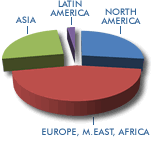
The three major areas of focus in food and beverage manufacturing are cost management and margin protection, more sustainable manufacturing focused on energy usage and waste reduction, and the improvement of food safety. To stay competitive, processors are concerned about quality product, packaging and manufacturing innovation. Since most processors have similar business strategies, flawless and timely execution differentiates the leading companies from their competitors, says the study.
Key automation products to help processors get control of their processes include enterprise asset management, motion control, laboratory information management systems, plant asset management, AC drives, programmable controllers, distributed control systems, process safety systems, HMIs, field transmitters and valves, process engineering tools, real-time process optimization and production management.
According to the study, the outlook for the food and beverage industry in 2010 will be moderate due to the global recession, changing consumer purchasing patterns and tightening budgets. The industry has been one of the least affected by global recession. However, the industry expects growth in consumer spending to remain at reduced rates into the foreseeable future. Information tools will help the consumer be selective in product purchases, and processors will need to use these tools to reach consumers.
“The information architecture is extending its reach all the way to the consumer by way of social networks and a new generation of truly virtual on-line shopping product customization tools,” says John Blanchard, principal analyst for the CPG industries. “It is becoming an important solution in the drive toward mass customization and has begun to change the way consumer-facing business is conducted,” he concludes.
The study also looks at new regulations and global standards, emerging markets, urbanization, the Wal-Mart effect, new information architectures, ISO 22000/PAS 220, packaging and the supply chain, productivity initiatives, portfolio optimization and market and channel expansion. For more information, visit the ARC Advisory Group Web site.
